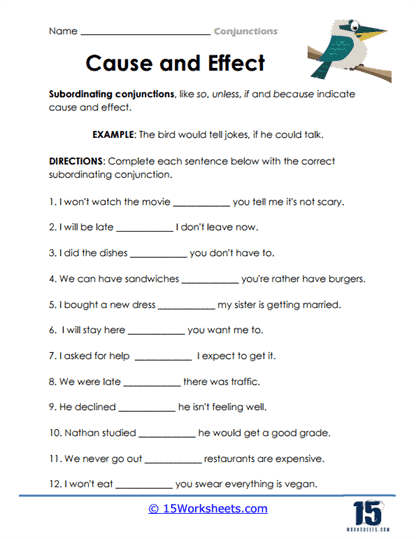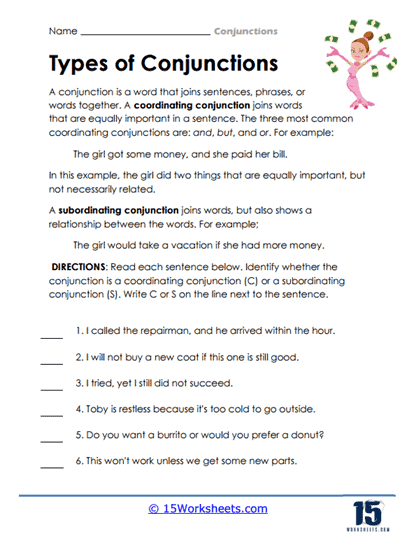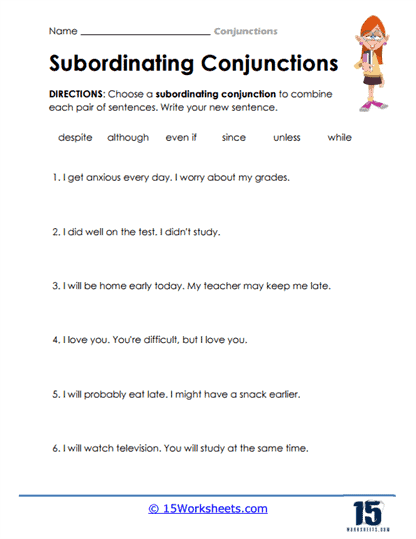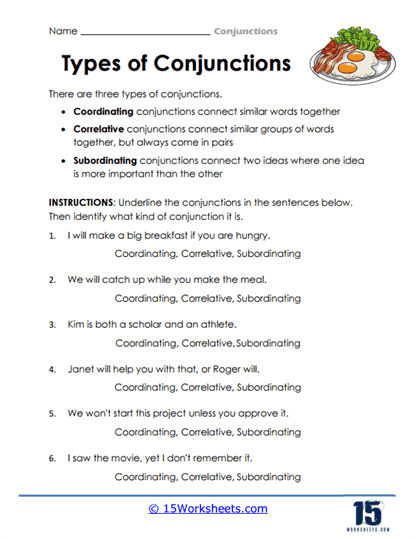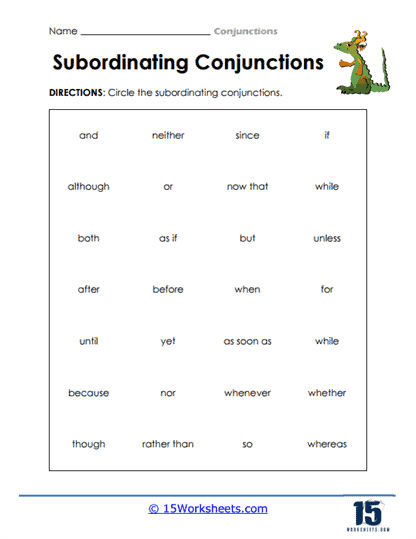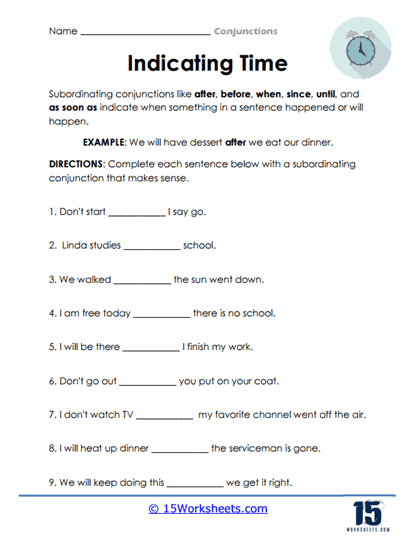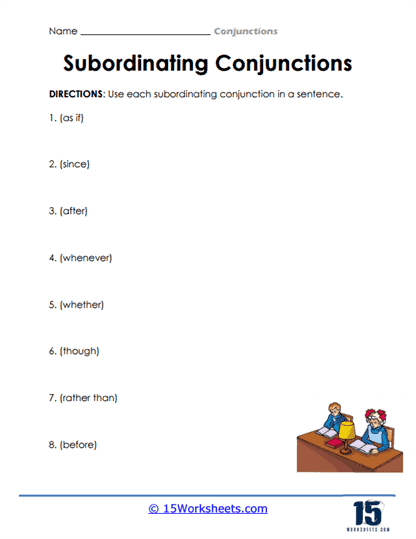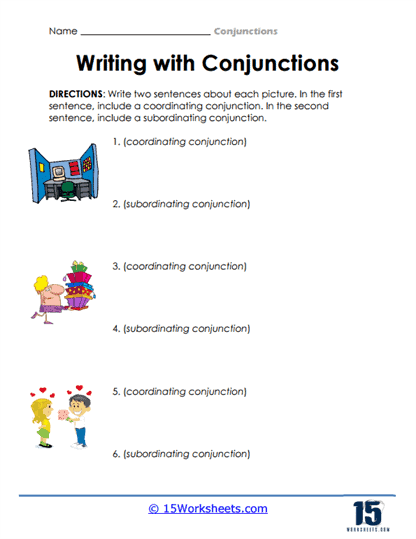Conjunctions Worksheets
All About These 15 Worksheets
These conjunctions worksheets are carefully crafted to foster a deep, practical understanding of conjunctions and their vital role in English grammar. Conjunctions-such as “and,” “but,” “because,” and “although”-are the essential threads that stitch together the parts of a sentence, allowing ideas to flow logically and cohesively. They serve as linguistic bridges, connecting not just words and phrases, but entire thoughts, which helps create meaning and structure in both spoken and written communication.
By providing a structured approach to learning, these worksheets enable students to explore the full range of conjunctions-coordinating, subordinating, and correlative-while developing the ability to recognize and use them appropriately in different contexts. Students move from basic identification and fill-in-the-blank activities to more complex sentence-combining tasks and writing prompts. This progression supports not just rote learning, but also analytical thinking and creativity, as students begin to see how the choice of a conjunction can alter the tone, meaning, and rhythm of a sentence. Such exercises help solidify grammar concepts while simultaneously enhancing students’ overall writing skills.
The goal of these worksheets extends beyond simple grammar drills. They are designed to cultivate linguistic confidence and mastery, empowering students to express themselves with greater clarity and sophistication. Whether writing a narrative, presenting an argument, or analyzing a text, students who understand how to effectively use conjunctions can create more compelling, organized, and nuanced communication. For educators, these resources offer a reliable, engaging way to teach an often-overlooked but fundamentally important aspect of grammar that underpins all fluent, effective writing.
An Individual Look At The Worksheets
Starting with “Building Bridges,” students embark on a quest to connect ideas seamlessly. This worksheet emphasizes the importance of conjunctions in constructing meaningful sentences, much like engineers building sturdy bridges to connect distant lands. It’s a foundational exercise that sets the stage for more complex conjunction challenges ahead.
Next up is “The If-Unless Conundrum,” where students navigate the tricky terrain of conditional statements. By choosing between “if” and “unless,” learners explore the nuances of cause and effect, understanding how subtle shifts in conjunctions can alter the meaning of a sentence entirely. It’s a delightful dance of logic and language that keeps students on their toes.
“Using FANBOYS” introduces the classic coordinating conjunctions: For, And, Nor, But, Or, Yet, So. This worksheet transforms these everyday words into superheroes of sentence structure, each with its unique power to connect ideas. Students practice deploying these conjunctions to craft compound sentences, enhancing their writing’s clarity and flow.
In “Agree to Disagree,” learners delve into the art of expressing agreement and disagreement using conjunctions. This exercise encourages critical thinking and respectful discourse, teaching students how to articulate differing opinions gracefully. It’s a valuable skill, both in writing and in life, fostering thoughtful communication.
“Sentence Synthesis” challenges students to combine multiple ideas into cohesive sentences using appropriate conjunctions. This advanced exercise reinforces the importance of conjunctions in creating complex, nuanced thoughts. It’s the culmination of the conjunction journey, where students apply all they’ve learned to master the art of sentence construction.
What These Worksheets Cover
This comprehensive set of worksheets includes a diverse array of interactive exercises and activities aimed at reinforcing the correct usage of conjunctions. These materials cater to a range of learning levels and styles, making them suitable for classrooms, tutoring sessions, or independent study.
Some of the key exercises included are:
Fill-in-the-Blank Exercises – Students are given incomplete sentences and are asked to insert the appropriate conjunctions. This format helps them contextualize how different conjunctions affect sentence meaning.
Example: “I wanted to go for a walk, ___ it started to rain.”
(Correct answer: “but”)
Identification Exercises – Students read through sentences and identify various types of conjunctions. Specific worksheets focus on the seven coordinating conjunctions (for, and, nor, but, or, yet, so-often remembered with the acronym FANBOYS), as well as subordinating and correlative conjunctions.
Example: “Although it was late, she continued working.”
(Subordinating conjunction: “Although”)
Sentence Combining Tasks – Students are presented with two or more simple sentences and must combine them into a single, more complex sentence using suitable conjunctions. This builds skills in both grammar and sentence variety.
Example: “She was tired. She finished the project.”
(Possible answer: “She was tired, but she finished the project.”)
Creative Writing Prompts – These exercises encourage students to craft their own sentences or short paragraphs using specific conjunctions. This allows them to apply their knowledge in original and expressive ways, reinforcing both grammar and writing skills.
What Are Conjunctions-and Why Should You Care?
Conjunctions are those small but mighty words that help connect your thoughts. Whether you’re linking two words, phrases, or whole sentences, conjunctions are what keep your writing smooth and your ideas connected. Without them, our sentences would sound choppy and disjointed. In short, they help make our writing (and speaking) more natural and clear.
There are three main types of conjunctions you’ll come across. First, coordinating conjunctions like and, but, or so join things of equal importance-like two full sentences or two words. For example: “I like coffee and tea” or “She’s smart, but she’s also kind.” Then there are subordinating conjunctions, such as because, although, or if. These help connect a main idea with one that depends on it. Think: “Because it was raining, we stayed inside.” Finally, correlative conjunctions work in pairs-like either…or or not only…but also. You might say, “Either we leave now, or we miss the movie.” These pairings help balance two parts of a sentence equally.
There are three main types of conjunctions: coordinating conjunctions, subordinating conjunctions, and correlative conjunctions.
Coordinating conjunctions – These conjunctions are used to join words, phrases, or independent clauses of equal importance. Some common coordinating conjunctions include “and,” “but,” “or,” “nor,” “for,” “yet,” and “so.”
Examples:
– I like coffee and tea.
– She is rich, but she is not happy.
– You can go to the beach or the mountains.
Subordinating conjunctions – These conjunctions are used to join a subordinate clause (a clause that cannot stand alone as a sentence) to a main clause (a clause that can stand alone as a sentence). Some common subordinating conjunctions include “although,” “because,” “if,” “since,” “while,” and “when.”
Examples:
– Although it was raining, he still went out.
– Because she was sick, she couldn’t go to work.
– If you study hard, you will pass the exam.
Correlative conjunctions – These conjunctions are used in pairs to join two parts of a sentence that are grammatically equal in importance. Some common correlative conjunctions include “both…and,” “either…or,” “neither…nor,” “not only…but also,” and “whether…or.”
Examples:
– Both my brother and sister love music.
– Either you come with me, or I’ll go alone.
– Not only is she smart, but she is also funny.
Learning how to use conjunctions the right way makes a big difference. It’s not just about grammar-it’s about making your ideas come across clearly and confidently. With some practice (like using worksheets and exercises), you’ll start writing smoother, more connected sentences. And the better your writing flows, the easier it is to express yourself-whether you’re telling a story, explaining something, or just chatting in English.







